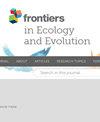Developing a DNA metabarcoding method to identify diet taxa in Neotropical foxes
IF 2.4
3区 环境科学与生态学
Q2 ECOLOGY
引用次数: 0
Abstract
Pampas and crab-eating foxes are medium-sized canids living in sympatry in the middle east of South America. Studies on the diet composition of these species provide a deep understanding of their ecological roles in the ecosystem structure and regulation. Using the metabarcoding technique, we analyzed the diet of both fox species in order to identify the vertebrate taxa included as food items. A fragment of the 12S ribosomal gene of the mtDNA was amplified using DNA extracted from 27 scat samples collected in south-central Uruguay during cold (June 2015) and warm (January – April 2016) seasons. A fox DNA blocking primer was designed to minimize the host amplicon products, and pooled samples were sequenced through paired-end reads (100 bp library) on a MiSeq Illumina Platform. The generated sequences were compared to a reference database built with sequences available in GenBank. In concordance with previous studies using traditional methods, we found that the most common food taxon were rodents. Qualitative differences in diet composition between both fox species were identified. Armadillo species were only found in pampas fox diet, while a greater variety of amphibians and birds were detected in crab-eating fox feces. Additionally, an innovative approach to differentiate between real and artifact sequences was employed. This method was based on comparing mutations at conserved and non-conserved positions within the secondary structure of the 12S rRNA, combined with network sequence reconstruction. Our results demonstrate the efficacy of the methodology in detecting the food species present in both fox diets, enabling the evaluation of intraspecific diversity among these species and facilitating the discarding of sequencing errors. This makes the methodology applicable to a wide range of studies.开发一种 DNA 代谢编码方法,以确定新热带狐狸的食物分类群
潘帕斯狐和食蟹狐是生活在南美洲中东部的中型犬科动物。对这两种狐狸食物组成的研究有助于深入了解它们在生态系统结构和调节中的作用。我们利用代谢编码技术分析了两种狐狸的食物,以确定作为食物的脊椎动物类群。我们使用从乌拉圭中南部寒冷季节(2015年6月)和温暖季节(2016年1月至4月)采集的27份粪便样本中提取的DNA,扩增了mtDNA的12S核糖体基因片段。设计了一种狐狸 DNA 阻断引物,以尽量减少宿主扩增产物,并在 MiSeq Illumina 平台上通过成对末端读数(100 bp 文库)对汇集的样本进行测序。生成的序列与根据 GenBank 中的序列建立的参考数据库进行了比较。与之前使用传统方法进行的研究一致,我们发现最常见的食物分类群是啮齿类动物。我们发现两种狐狸的食物组成存在质的差异。在潘帕斯狐的食物中只发现了犰狳类,而在食蟹狐的粪便中发现了更多种类的两栖动物和鸟类。此外,还采用了一种创新方法来区分真实序列和伪造序列。该方法基于比较 12S rRNA 二级结构中保守和非保守位置的突变,并结合网络序列重建。我们的研究结果表明,该方法能有效地检测出两种狐狸食物中的食物种类,从而评估这些种类的种内多样性,并有助于剔除测序错误。这使得该方法适用于广泛的研究。
本文章由计算机程序翻译,如有差异,请以英文原文为准。
求助全文
约1分钟内获得全文
求助全文
来源期刊

Frontiers in Ecology and Evolution
Environmental Science-Ecology
CiteScore
4.00
自引率
6.70%
发文量
1143
审稿时长
12 weeks
期刊介绍:
Frontiers in Ecology and Evolution publishes rigorously peer-reviewed research across fundamental and applied sciences, to provide ecological and evolutionary insights into our natural and anthropogenic world, and how it should best be managed. Field Chief Editor Mark A. Elgar at the University of Melbourne is supported by an outstanding Editorial Board of international researchers. This multidisciplinary open-access journal is at the forefront of disseminating and communicating scientific knowledge and impactful discoveries to researchers, academics and the public worldwide.
Eminent biologist and theist Theodosius Dobzhansky’s astute observation that “Nothing in biology makes sense except in the light of evolution” has arguably even broader relevance now than when it was first penned in The American Biology Teacher in 1973. One could similarly argue that not much in evolution makes sense without recourse to ecological concepts: understanding diversity — from microbial adaptations to species assemblages — requires insights from both ecological and evolutionary disciplines. Nowadays, technological developments from other fields allow us to address unprecedented ecological and evolutionary questions of astonishing detail, impressive breadth and compelling inference.
The specialty sections of Frontiers in Ecology and Evolution will publish, under a single platform, contemporary, rigorous research, reviews, opinions, and commentaries that cover the spectrum of ecological and evolutionary inquiry, both fundamental and applied. Articles are peer-reviewed according to the Frontiers review guidelines, which evaluate manuscripts on objective editorial criteria. Through this unique, Frontiers platform for open-access publishing and research networking, Frontiers in Ecology and Evolution aims to provide colleagues and the broader community with ecological and evolutionary insights into our natural and anthropogenic world, and how it might best be managed.
 求助内容:
求助内容: 应助结果提醒方式:
应助结果提醒方式:


